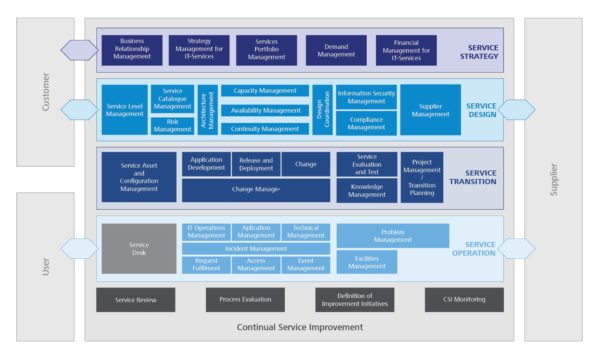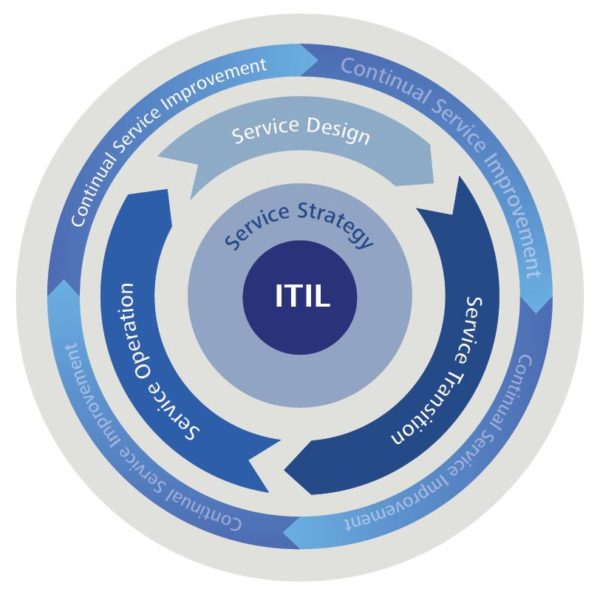IT service management (ITSM) refers to the entirety of activities – directed by policies, organized and structured in processes and supporting procedures – that are performed by an organization to design, plan, deliver, operate and control information technology (IT) services offered to customers.
from: Wikipedia (German)
The use of information technology has long since reached and penetrated almost all areas of operational value creation. Nothing works without IT anymore. However, as the complexity of processes along the industrial supply chain increases, so do the demands on the IT systems involved. There has long been an unmanageable number of systems, architectural approaches and best practices that can be used to solve a wide variety of tasks. However, the overview can quickly get lost. After all, each of these solutions has its advantages and disadvantages.
This is exactly where IT Service Management comes in, because it is dedicated to these challenges: Increasing efficiency, process quality and profitability.
Service definition according to ITIL®: A way to add value for customers by facilitating or promoting the achievement of the results the customer is aiming for. In doing so, the customers themselves do not have to bear responsibility for certain costs and risks. The term service is sometimes used as a synonym for Core Service, IT Service or Service Package.
from: IT process maps (German)
ITIL®: IT Infrastructure Library; is a collection of predefined processes, functions and roles typically found in any IT infrastructure of medium and large enterprises.
from: Wikipedia (German)
ITSM includes all computer-supported measures and processes to shift the focus of the service provider from a purely technical view of the structures to the best possible service performance and thus customer orientation. The aim is therefore to orient the entire company towards maximum effectiveness and customer satisfaction in order to create a stable and cooperative relationship of trust.

Good IT service management brings profit to the customer in the form of added value in the design of his operational processes by clearly defining them and thus ensuring transparency and consistently high quality. To achieve this, ITSM must be tailored to the individual needs of a company. This begins with a comprehensive analysis of the requirements for the service to be provided at the beginning of the service take-over. This is followed by the selection and transfer of the required modules from the service portfolio into the service catalogue. In this way, the customer gets exactly the services he needs.
While the service portfolio is compromised by all services offered by the service provider, the customer-specific service catalogue contains all information on the services currently provided for the customer. The service catalogue also lists the status of all operational and implementation services.
During the contract term, a help desk is available to the customer as a contact point for questions, problems or change requests. Special attention should be paid to this interface, as this is where the customer’s subjective perception of quality is formed:
- How competent is the service employee?
- How good are the answers/solutions?
- How fast is the response?
- Is anyone reachable at all?
The quality framework for service provision is defined by the Service Level Agreements (SLA). Among other things, they describe the scope of services to be provided, the requirements for response times and availability.

An IT service is also subject to a natural aging process – both on a technical level (outdated hardware and software) and from a business perspective (changed requirements and processes). For this reason, the Continual Service Improvement (CSI) process is of importance: On the one hand, it is about reacting to the knowledge gained from issue management. On the other hand, the strategic development should be planned and monitored in order to be able to meet future requirements. This is done according to the Deming-cycle (Plan-Do-Check-Act cycle, PDCA cycle) – an iterative process for implementing changes and their continuous improvement.
A good CSI ensures that the customer’s service expectations can be met in the future. This forms the basis for a lasting relationship based on partnership.
The IT Infrastructure Library
The IT Infrastructure Library (ITIL) describes a total of 26 core processes, the basic procedures and components of IT services as well as the roles and functions involved. These are grouped in five core disciplines. However, these are by no means rigid instructions for action, but rather a collection of best practices and suggestions on how to implement effective IT service management. These core disciplines are:
- Service Strategy: Developing and defining a strategy for delivering services to the customer, based on the customer’s needs and market requirements
- Service Design: Development of optimal solutions based on concrete requirements and their implementation
- Service Transition: Roll-out and commissioning of IT services
- Service Operation: Ensuring efficient service delivery
- Continual Service Improvement: continuous service improvement using quality management methods

In the following blog posts I will go into more detail about the individual disciplines and processes according to ITIL and explain their application within Saxonia (since 03/2020 ZEISS Digital Innovation).
Translated with www.DeepL.com/Translator (free version)
References:
IT Process Wiki, 2019, wiki.de.it-processmaps.com
Otto Geißler/Ulrike Ostler, 2018, datacenter-insider.de
ITIL.org, 2018, blog.itil.org